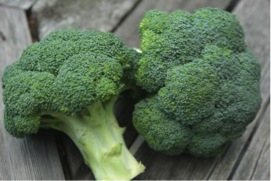
- Starting the Plants from Seeds
- Soil Requirements
- Planting
- Irrigation, Fertilization and Weed Control
- Variety Selections
- Harvest
- Cooking and Storage
- Diseases and Insects
Broccoli is a cool-weather vegetable that can easily be grown in the garden in early spring or fall. Broccoli belongs to the Brassica family. Research shows that plants from this family are extremely healthy to consume and have the potential to reduce certain types of cancer.
Starting the Plants from Seeds
For a late spring harvest, start seeds indoors or in a cold frame or greenhouse at the beginning of February. Seedlings should be hardened off before planting them in March by leaving them outside for a few hours every day. After three days, plants can be left overnight. For a fall harvest, start seeds indoors at the end of July. Plant them in the garden by the end of August.
Soil Requirements
Broccoli can grow well in a wide range of soils but does best in heavily organic- amended, well-drained areas. Broccoli grows best in soils with a pH between 6.0 and 6.8. Clay soils, like those in Georgia, should definitely receive the addition of some topsoil, compost or manures in order to increase drainage and available nutrients. A soil test should be completed to accurately determine soil pH and increase the chances of planting success.
Planting
Find a garden location that will have at least six to eight hours of sun per day for optimum plant growth. Till the bed to a depth of 8 to 10 inches and remove any sticks and stones. In the absence of a soil test, incorporate 3 to 4 pounds of 5-10-10 fertilizer per 100 square feet of the garden area. Smooth the soil with a rake and plant the seedlings 18 to 20 inches apart.
Irrigation, Fertilization and Weed Control
Broccoli requires proper irrigation to achieve optimum growth. Water plants daily for the first week to get the crop established. Continue to irrigate broccoli every four to five days, as needed, to keep the plants healthy.
Broccoli is a fairly heavy feeder and will require additional nutrients. After initial fertilization at planting, apply 2 pounds of 5-10-15 fertilizer or equivalent per 100 square feet of bed each month during the growing season. Mulch broccoli with pine straw or leaves to keep weeds away and to preserve moisture in the soil.
Variety Selections
There are many varieties to try, including: Marathon, Packman, Patriot, Premium Crop, Bravo and Decathion.
Harvest
Harvest the heads when the florets around the edges of the head start to loosen a bit but the center of the head is still tight and green. Removing the heads when they are younger and 6 to 8 inches across will help ensure a tastier crop. Cut the stems at an angle to keep water and diseases at bay. After cutting the initial head, broccoli stems will produce smaller secondary heads. Continue to harvest these throughout the growing season.
Cooking and Storage
Cook or steam broccoli or refrigerate the heads soon after harvesting. Broccoli can be frozen by steam-blanching prior to freezing.
Diseases and Insects
The most serious broccoli pest is cabbageworm. Cabbage root maggots can also be a problem. Both diseases and insects can be controlled by using sound cultural garden practices and recommended chemicals when necessary.
Status and Revision History
Published on Aug 07, 2012
Published with Full Review on Mar 28, 2017
Published with Full Review on Jun 09, 2020
Published with Full Review on Jun 21, 2022


























































